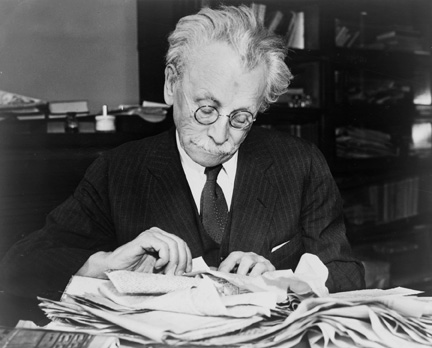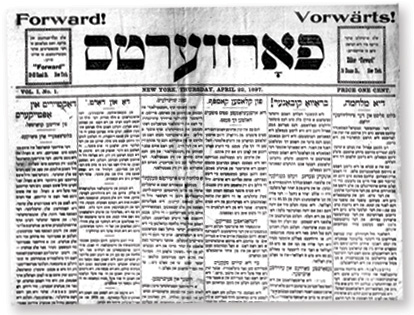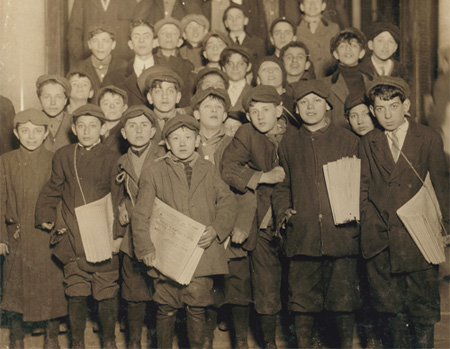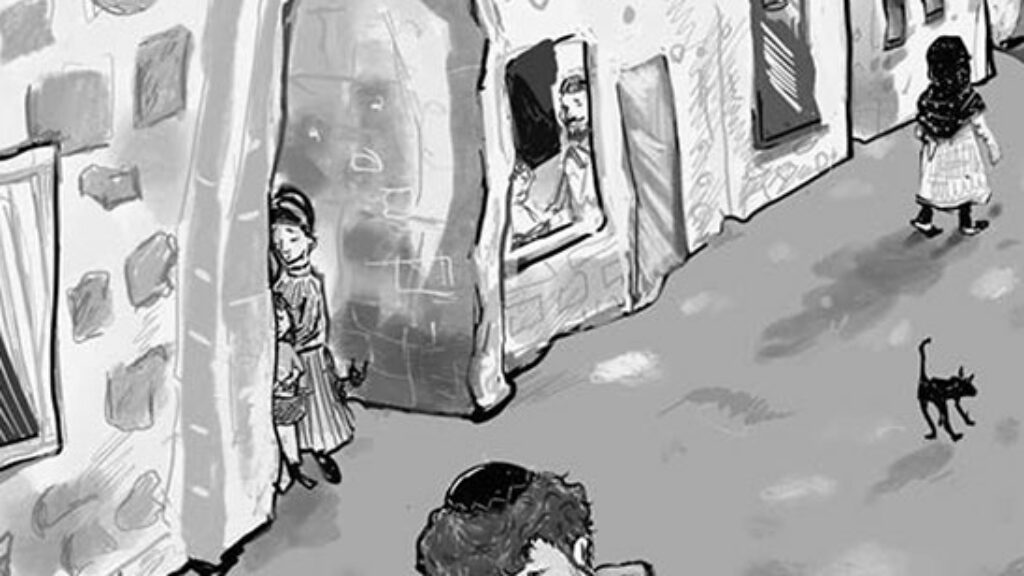Eden in a Distant Land
In the 1950s I spent several summers at a Jewish children’s camp called Kinderland located on the shore of Sylvan Lake, about 60 miles north of New York City. The camp, founded in 1924, was run by the Jewish People’s Fraternal Order, a front group of the Communist Party USA. On the other side of the lake, about 500 yards away, was another Jewish children’s camp called Kinder Ring, sponsored by the socialist Workmen’s Circle. It was the middle of the Cold War and virtually no contact was permitted between the children of the two camps. Yet sometimes our rowboats passed each other in the middle of the lake. The kids from Kinder Ring called us “commies” and we returned fire by calling them “social fascists,” a political term of art we learned from our elders. What the two camps had in common, though, was that the children were taught a smattering of Yiddish words and that each camp was connected to a daily Yiddish newspaper. Theirs was called the Forverts (Forward), and ours was the Morgen Freiheit (Morning Freedom).
It all seemed somewhat outdated and absurd, but what I didn’t know at the time was that our battles at Sylvan Lake had their roots in a serious cultural and ideological conflict dating from the beginning of the last century. In one of the great mass migrations in history, roughly two million impoverished Jews arrived from Eastern Europe to build a new life in the United States. Half of these mostly Yiddish-speaking Jews settled in New York City, primarily on the Lower East Side. By their own efforts they created a democratic community life and a cultural renaissance. Great literature appeared in Yiddish and English, and a flourishing Yiddish theater emerged. In the 1920s, a half-dozen Yiddish daily newspapers, including the Forverts and the Freiheit, were regularly published in the city. From the grass roots, the new immigrants built a network of self-help social welfare organizations, militant trade unions, and political parties of the Left. It’s no exaggeration to say that the cultural and political ferment in this one American city (and mostly in one neighborhood) not only profoundly influenced the history of the Jewish people but also had a positive impact on America’s democratic institutions.

By far the most interesting and influential figure in this immigrant tapestry was the multi-talented Abraham Cahan. Cahan was 22 years old when he arrived on the Lower East Side in 1882 from the Lithuanian city of Vilna, then part of the Russian empire. Fifteen years later, he founded the Forward. Cahan became a highly acclaimed novelist in Yiddish and English, a friend of leading American writers, and one of the most influential leaders of the anti-Communist Jewish labor movement. Along the way he also managed to write a two-volume history of the United States in Yiddish.
Thus, there is cause for celebration that Seth Lipsky has now produced the rich biography Cahan deserves. It’s hard to imagine a better match of author and subject matter. Lipsky was a longtime reporter and editor for The Wall Street Journal, then became the editor of the revived English-language edition of the Forward in 1991(the Yiddish-language Forverts still appears), and was the founding editor of The New York Sun. Like Cahan, he has printer’s ink running through his veins.
Lipsky places Cahan in the pantheon of great American newspaper editors with a social justice agenda, alongside such historic figures as William Lloyd Garrison and Charles Dana. In his account of Cahan’s political commitments, Lipsky relies on a deep knowledge of the ideological battles between socialists and communists, Zionists and Yiddishists that raged almost a century ago. Cahan’s amazing life story encompasses all of the vexing and often tragic aspects of the Jewish question in the 20th century—not the “Jewish Question” as understood by the leaders of Christian Europe, but rather the question of what was to be done about the Jewish plight in anti-Semitic Europe as it was debated by the Jews themselves.
Cahan received his early education in Vilna, a center of Jewish learning often referred to as the “Jerusalem of Lithuania.” He attended a local cheder, yet also yearned for a broader secular education. At the age of 15 he began spending hours each day at the Vilna public library, reading the great Russian novelists and dabbling in the fashionable philosophies of the day, including Marxism. “The Vilna public library became for me a temple of learning and inspiration,” Cahan later wrote.
Like many other young Jews facing a dismal future in Russia, Cahan was torn between the religious traditions of his parents and the allure of secular universalism and revolution. He couldn’t avoid responding to the rising violence directed against the Jews by the Tsarist authorities. At the age of 21 Cahan proclaimed himself a socialist and joined one of the clandestine underground groups plotting the overthrow of the monarchy.
It’s intriguing to speculate on what role an eloquent leader like Cahan might have played in the revolutions of 1906 and 1917 or which socialist party he would have aligned with had he remained in Russia. But after briefly toying with the Zionist ideal of building a Jewish homeland in Palestine, Cahan fell in love with America. “To go to America!” Cahan later wrote. “To re-establish the Garden of Eden in that distant land. My spirit soared. All my other plans dissolved. I was for America!”
The 22-year-old Cahan arrived in New York in 1882 and settled on the Lower East Side. Renting a room near the Bowery, he soon discovered that it would take lots of radical reform before his beloved America could qualify as a “Garden of Eden.” He could see and smell the grinding poverty into which the newly arriving waves of immigrants were thrown. Cahan himself found a job as a worker in a cigar factory, which also employed Samuel Gompers, the future leader of the American Federation of Labor. He immediately enlisted in the workers’ struggle to combat the exploitation and unsafe conditions in the workplace. As Lipsky recounts, Cahan gave speeches at workers’ meetings about Marx’s theory of “surplus value” and “the inevitability of the coming of socialism.” They were among the first socialist speeches given in Yiddish in America.
Lipsky shows how Cahan’s radical socialism emanated from his fears about the plight of the Jews—not only those who had made it to America, but also the vast number still suffering in Europe. Cahan believed that a socialist transformation of society would not only bring justice to all humanity, but would provide the only lasting solution to the endless persecution of the Jews. He was convinced that after the elimination of capitalism there could not be “an economic or political reason for anti-Semitism.” It would take almost half a century for Cahan to disabuse himself of this and other Marxist fantasies.
In addition to his socialist activism, Cahan honed his literary talents. Now completely fluent in English, he wrote articles about social and political issues for the official publication of the Socialist Labor Party, The People. As Lipsky nicely puts it, Cahan worked on creating socialism by day but dreamt of producing great literature by night. He began writing fiction for Yiddish newspapers and for English publications such as Short Stories magazine. One of his stories was noticed and praised by the great realist novelist William Dean Howells. In 1896, with Howells’s encouragement, Cahan brought out his first novel, Yekl: A Tale of the New York Ghetto.
All of Cahan’s diverse talents and political passions came together with the creation of the Forward in 1897. Lipsky sees the founding of the Forward as one of the three events of that year that “changed the course of Jewish history”—the others being the first Zionist Congress in Basel, Switzerland (about which Theodor Herzl declared that “At Basel, I founded the Jewish State”) and the establishment of the socialist Jewish Bund in Eastern Europe.
Lipsky may be exaggerating here, but not in the way you might think. Herzl’s declaration at Basel would have been long forgotten were it not for the diplomatic efforts of Chaim Weizmann and the political leadership of David Ben-Gurion to secure the Jewish State. The Bund was an important mass movement in Eastern Europe, but it failed in its quest to create a political foothold for Jewish socialism. By contrast, the Forward had an immediate, large, and lasting influence on Jewish and, as Lipsky shows, American life.

The Forward was launched during the era of “yellow journalism” in which, according to Lipsky, “some fifty-eight dailies in New York alone jostled for attention.” To compete, Cahan blared out his paper’s mission with chutzpah that would make today’s tabloid editors blush. Best to let Lipsky, the admiring editor, describe Cahan’s first front page:
On April 22, 1897, the Forward jumped into this mix in full Marxist regalia, with the slogan “Workers of the World Unite!” at the top of its front page. The headlines of that first issue included “Blood Runs in Central Europe” (on the Turkish-Greek war), “Bravo Cubans!” (supporting the island’s resistance to Spain), and “From the Class Struggle: Locked-out Steamfitters are Holding Fast.”
The Forward’s combination of Marxism and sensationalism was meant to catch the working class Yiddish reader’s eye as he or she passed the newsstands or one of the hundreds of “newsies” who distributed the paper. But below the agitprop headlines, Cahan was running serious critical journalism. The paper’s editors and reporters were competing with figures such as Lincoln Steffens and Jacob Riis (both of whom had been early mentors of Cahan) in writing about the terrible conditions in the slums. Cahan himself contributed hundreds of articles on every imaginable social issue, from criticisms of capitalist economics to why it was acceptable for Jewish parents to allow their children to play baseball, which was one of the first pieces in the paper’s popular advice column “Bintel Brief.”
Under Cahan, the Forward also became the place readers went to sample the greats of Yiddish literature written in America. Cahan regularly published popular writers such as Sholem Asch, Avraham Reisen, and Israel Joshua Singer, author of the best-selling The Brothers Ashkenazi. Eventually the younger of the Singer brothers, Isaac Bashevis, came on board in 1935. Some of the work that eventually won Singer the Nobel Prize in Literature in 1978 originally appeared in the pages of the Forward.
While editing the Forward and continuing to participate in socialist and labor politics, Cahan somehow found time to write more fiction. In 1919 he published his masterpiece, The Rise of David Levinsky, a novel of social realism which chronicles the life of a poor Jew who escapes from Russia and rises to financial success in capitalist America, but loses his religion and his soul. The novel received widespread critical acclaim. H.L. Mencken wrote that “no better novel about the immigrant has ever been written, or is likely to be written.” After its publication, Cahan was pushed by some friends, including Mencken, to devote himself entirely to literature.
Instead, for the next two momentous decades Cahan worked relentlessly to make the Forward even more influential, not only in journalism but also in the wrenching debates among the Jews about how to respond to the three world-changing political movements that emerged in the years between the two world wars: communism, fascism, and Zionism.
With other American radicals, Cahan initially greeted the Bolshevik revolution with sympathy. But Cahan soon grasped the nature of the new tyranny that the revolution had put in place (a fact-finding trip to Russia in 1927 helped). At a time when many on the Left, including the writers and readers of the Freiheit, were still moved by the romance of communism, Cahan increasingly used his paper’s enhanced resources and credibility—by the middle of the 1920s the Forward’s daily circulation figure had reached an astonishing 250,000—to describe the true nature of Soviet totalitarianism. He sent reporters to Soviet Russia and, ahead of most other daily newspapers, revealed details about the Siberian prison camps and mass starvation in Ukraine. In the estimate of the historian Richard Gid Powers (quoted by Lipsky) Cahan was “the most important Jewish anticommunist of the twenties.”

Cahan was just as prescient about the dangers of the emerging Nazi regime in Germany. He denounced the Munich agreement as a sellout of the democracies and was outraged by the Nazi-Soviet non-aggression pact. In a Forward editorial—written at a time when many Jewish leftists were still making excuses for Stalin—Cahan declared: “Stalin is Hitler’s partner in his setting the world in flames. Let us remember that. Let us pass it down to our children’s children.”
Cahan did not come to Zionism by theory but rallied to the Zionist cause out of a sense of Jewish solidarity. In 1925 he traveled to Palestine and wrote a long series of mostly positive dispatches for the Forward on the practical accomplishments of the Jewish settlers in Eretz Yisrael. In 1929 the Palestinian Arabs revolted against the British Mandatory authority and carried out a massacre of religious Jews in Hebron. Cahan reacted with fury in the pages of the Forward, describing “savage Arab masses, incited by their own leaders and permeated with dark chauvinism—the root of all wars, of all misfortunes.” The paper also lashed out with scorn at the rival Freiheit, which, following the Soviet party line, called the Hebron slaughter a “revolt against British and Zionist imperialism.”
Working for the independence of Israel was Cahan’s last great cause. He died on August 31, 1951 at the age of 91. Ten thousand people turned out for the funeral on the Lower East Side. Eulogies were given by Ambassador Abba Eban, representing the young state of Israel; New York City’s Mayor Vincent Impellitteri; and other dignitaries. Representing President Harry Truman, U.S. Secretary of Labor Maurice Tobin told the mourners, “We should as Americans say ‘Thank God’ for the day Abe Cahan arrived in the United States.”
Suggested Reading

Radical Kindness and Heroic Dogs: A New Anthology of Yiddish Children’s Literature
Honey on the Page, like the best anthologies, is an eye-opening work of literary history, gleefully introducing a sea of lightly known authors through both their work and through meticulously crafted biographical sketches.
Crowds and Converts: A Response to Abraham Socher
Tal Keinan has written an interesting response to Abe Socher’s review of his book, which takes the conversation in a new direction.
Why There Is No Jewish Narnia
So why don’t Jews write more fantasy literature? And a different, deeper but related question: why are there no works of modern fantasy that are profoundly Jewish in the way that, say, The Lion, the Witch, and the Wardrobe is Christian?
Jewish Geography
The Jewish peddler, the “slave of the basket or the pack; then the lackey of the horse,” did not have an easy time of it.
Comments
You must log in to comment Log In